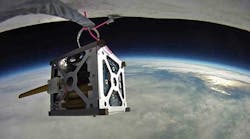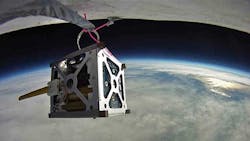This week’s New Scientist included a short piece “CubeSat Craze Could Create Space Debris Catastrophe.”
Paul Marks, the author, writes: “CubeSats are supposed to come down within 25 years. However, there is no enforcement of this rule.”
He then adds a quote from Hugh Lewis, of the University of Southampton: "Some CubeSat operators are knowingly putting their craft into orbits that will last much longer than 25 years, with some as long as a hundred years," (Lewis is to speak at the International Astronautical Congress in Toronto, the week of September 29 about the problem.)
The part that shocked me was the statement that, “CubeSat popularity looks likely to increase. Around 100 of the craft were launched between 2003 and 2012; then another 100 were launched in 2013 alone. Lewis and his colleagues extrapolated those numbers to model what would happen if between 205 and 700 CubeSats were launched every year for the next 30 years.[1]
“At the 205-per-year launch rate, CubeSats will come within a dangerously close 17 kilometers of other spacecraft 16 million times over the three decades. At the highest rate, that rises to 165 million times.”
Verifying the Count
Those numbers seemed off by orders of magnitude to me, as I had blogged about PhoneSats twice in the past year: (“Designed Any Satellites Lately? Here's Your Chance,” without realizing that PhoneSats are a subset of CubeSats – in fact a democratization of the concept.
Here’s the bigger picture: To a large extent, CubeSats have been the domain of university and government researchers. Providing them with instrumentation and radios has largely been carried out ad-hoc. In contrast, PhoneSats use off-the-shelf smartphone hardware to run applications and communicate. After all, the average smart phone already has many of the systems needed for a satellite, including fast processors, relatively big memories, versatile operating systems, multiple miniature sensors, high-resolution cameras, GPS receivers and multiple radios.
Their manufacturing scale reduces their cost and their notorious hackability makes them accessible to a wide range of potential experimenters. You don’t need a Ph.D. advisor with a grant; any high-school science teacher can pass the hat during halftime at a basketball game. (Maybe someone will even toss her previous-generation Android phone in the hat.)
But they are a relatively new concept and today, and in orbit, they are far outnumbered by CubeSats.
In contrast, if you go the Wikipedia entry on CubeSats, you will find a list (which needs updating) of all CubeSat-dimensioned satellites, including PhoneSats, that have been placed into orbit. At the time the list was last updated the count was138, including PhoneSats.
Another current Wikipedia entry, on PhoneSats, lists three PhoneSat launches: a triple (three on one rocket) in April of 2013, a single the following November, and a single, last April 18[2]
Thus Lewis’ note of alarm, based on extrapolating the current launch rate of all kinds of all kinds of CubeSats is valid.
The worrisome part of the New Scientist article goes on to say that, “CubeSats are supposed to come down within 25 years. However, there is no enforcement of this rule.” It goes on to quote Lewis as saying, "Some CubeSat operators are knowingly putting their craft into orbits that will last much longer than 25 years, with some as long as a hundred years,"
[1]Worryingly, the simulation has already proved accurate in one instance. It predicted CubeSat collisions should have started in the 2013 to 2014 period and, sure enough, the first one happened in May 2013. It resulted in the loss of Ecuador's first CubeSat.
[2]If you’re rooting for the little guys, it’s interesting to note all of these satellites were carried aloft by civilian rcocketeers. The first two used launch vehicles made by Orbital Sciences, the last, a rocket from SpaceX.

